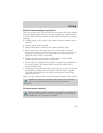
System park
With both controls in for normal run modes, the parking brakes on both
tractor and trailer may be actuated by pulling the yellow control (parking
brake) out, which exhausts the air from the tractor spring brakes and
simultaneously causes the red control (trailer supply) to pop out,
applying the trailer brakes. This complies with federal regulations stating
one control must apply all the parking brakes on the vehicle.
Trailer charge
If both controls are out when parking the combination vehicle and it is
desired to recharge the trailer (leaving the tractor spring brakes
applied), the trailer air supply control may be pushed in, repressurizing
the trailer supply line. This mode could also be used to park a
combination vehicle with air actuated emergency brakes on the trailer to
provide demonstrated parking capability with tractor spring brakes only.
Automatic application
With both controls in (in the normal run configuration), if the supply
pressure to the push-pull valves is reduced to approximately 240 to 310
kPa (35-45 psi), the red control (trailer supply valve) must pop out,
applying the emergency or parking brakes on the trailer. If the red
control is held in manually and the pressure decreases to approximately
172 to 240 kPa (25-35 psi), a tripper piston within the MV-3 valve will
move upward. This will exhaust the trailer supply, causing the required
non-override feature. The yellow control (parking brake) will pop out at
approximately 138 to 207 kPa (20-30 psi).
Reservoir selection
The number one service reservoir will at all times be selected as the
primary supply source for the MV-3. This is accomplished automatically
by the function of the dual circuit supply valve contained in the body of
the MV-3. Only in the event of a pressure drop of more than 207 kPa (30
psi) below that of the number two service reservoir will the dual circuit
supply valve shuttle and establish the front service reservoir as the
supply.
Driving
126


















